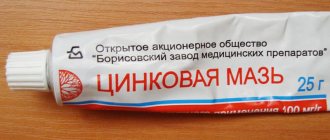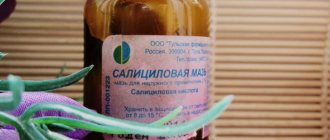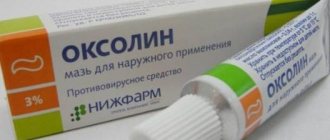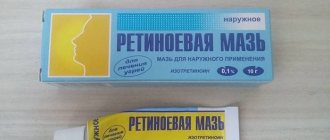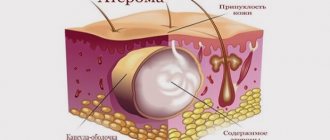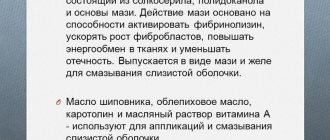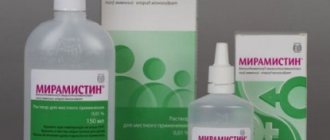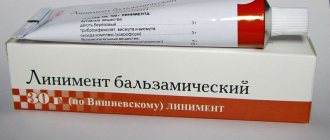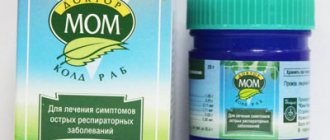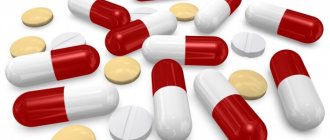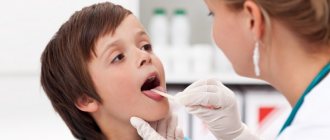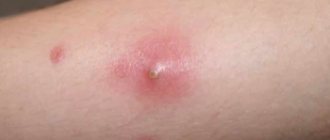What to consider when using the drug
Hydrocortisone ointment should be used only as directed by a doctor.
Particular attention should be paid to the use of the medicine in children, since hydrocortisone acts much faster on the child’s body. It can suppress the functioning of the adrenal cortex, possibly reducing the production of growth hormone - somatropin. Therefore, treatment of children with hydrocortisone ointment should be carried out strictly under the supervision of a doctor. It is possible to shorten the course of treatment, but this depends on the sensitivity of the child’s body. It is necessary to avoid contact of the drug with mucous membranes. The age limit for a drug such as hydrocortisone ophthalmic ointment should be taken into account. Instructions for use indicate that the medicine is not recommended for use under 18 years of age.
If you use this remedy over large areas of the body, you need to follow a diet that includes:
- salt restriction;
- increasing the amount of foods containing potassium;
- eating enough protein.
- arterial pressure;
- blood condition: coagulability, glucose;
- the volume of urine produced over a certain period of time;
- patient weight;
- plasma cortisol level.
If after 7 days there is no improvement, or the situation worsens, you should immediately consult a doctor. You will need to consult a specialist if, after therapy, signs of the disease return again. To exclude infectious lesions, it is necessary to combine antibacterial and antifungal drugs with the ointment
Particular caution during the use of the ointment should be observed when working with machinery, when driving a car and in situations where increased concentration and quick reaction are required.
Hydrocortisone ointment is also widely used for wrinkles under the eyes. We will find out reviews about the effectiveness of the drug in this direction a little later.
Contraindications for the patient
The use of hydrocortisone ointment is contraindicated if you have an individual intolerance to this hormonal drug.
There is a list of diseases for which the use of the drug is excluded:
- rashes of a syphilis nature;
- tuberculous diseases of the organs of vision and skin;
- during vaccination and after;
- skin oncology;
- children under 2 years of age (due to possible suppression of the adrenal cortex, which develops quickly in children);
- infections of viral, fungal origin;
- violations of the skin, its integrity (ulcerations, cuts, wounds) or ocular epithelium;
- rosacea-like or perioral dermatitis;
- inflammatory diseases caused by improper functioning of the sebaceous glands;
- chronic recurrent skin diseases on the face, provoked by neuroparalytic disorders, when hyperemia is a consequence of the malfunction of vasodilator and vasoconstrictor nerve endings, causing redness and swelling of the skin and mucous membranes simultaneously with an increase in their temperature;
- chlamydial infectious diseases of the eyes, affecting the conjunctiva and cornea with possible scarring and complete blindness.
Hydrocortisone ointment instructions for use
The ointment is used exclusively as directed by a doctor. The duration of the course is 1-2 weeks, but at the discretion of the doctor, the duration of treatment can be extended to 20 days, depending on the severity of the pathology. The drug is applied to cleansed skin in a thin layer 2-4 times a day to the affected area, then gently rubbed in with your fingers. For inflammatory infiltration, the product is used together with an occlusive dressing. Sealed insulation protects the skin from air and moisture.
The eye ointment is placed into the conjunctival sac with a disposable spatula 1-2 times a day with an occlusive dressing and 2-3 times a day if it is not used. Ultrasound is often combined with hydrocortisone. The procedure is called phonophoresis. The process is effective when:
- treatment of joints;
- muscle atrophy;
- post-burn scars;
- trophic ulcers;
- varicose veins;
- pathologies of ENT organs;
- painful injuries;
- fractures of tubular bones;
- used in neuralgia and gynecology.
For children
A child often develops atopic dermatitis on the scalp and face (especially on the cheeks). The rash often begins in the creases of the knees and elbows, between the legs and buttocks. The disease is especially aggravated when the baby scratches itchy pimples with his nails and colonizes bacteria under the skin, causing inflammation. In this case, most doctors will recommend hydrocortisone ointment in low concentration and low dosage, so as not to expose the child to psychological stress
However, it must be used carefully so that the drug does not negatively affect the baby’s development.
During pregnancy
While expecting a baby, hydrocortisone should be used as a last resort when safe drugs do not help. If a positive effect is observed from treatment with this hormonal drug, then doctors allow it to be used by a pregnant woman at any stage. During lactation, it is better to avoid using Hydrocortisone. If use is necessary, breastfeeding should be stopped for the entire course of treatment.
Types of procedures using it
Physiotherapy makes extensive use of hydrocortisone. Among the effective procedures:
- electrophoresis - the technique is based on the combined effect of direct current and drugs introduced into the body with its help (the drug is used in ampoules);
- ultrasound treatment (ultraphonophoresis) - this procedure allows you to achieve a high concentration of the drug and its deep penetration exactly into the place that needs to be treated (ointment, gel are used);
- phonophoresis is a procedure similar to ultrasound treatment, but hydrocortisone is used here in the form of a suspension.
You will find the causes of development, symptoms, treatment methods and photos of allergic dermatitis in adults and children in this material.
You can learn about the effective treatment of herpes stomatitis in children from this publication.
pharmachologic effect
The active component, hydrocortisone acetate, when applied externally, has anti-inflammatory, immunosuppressive and antiallergic effects.
- The anti-inflammatory effect is associated with inhibition of the production of inflammatory mediators, decreased activity of leukocytes and macrophages - blood cells migrating to the site of inflammation, narrowing of small vessels, decreased release of fluid from the bloodstream and the formation of inflammatory edema.
- The immunosuppressive effect is achieved by suppressing the activity of immune blood cells - T and B lymphocytes, interferon, interleukins and other mediators, the excessive production and pathologically enhanced work of which occurs during autoimmune processes.
- The antiallergic effect includes suppression of the production of antibodies and the destruction of mast cell granules, the contents of which are the main mediators of allergy - histamine and leukotrienes.
Is it possible to replace the medicine?
Cortisone ointments are generally well tolerated by users. The medication must be replaced only in exceptional cases. Many consumers, when prescribing a particular drug, try to find a medicine with the same effect, but cheaper. This is not required in this situation. After all, the cost of one package of the drug does not exceed 40 rubles.
Drug analogs should only be selected by a doctor. These include Cortimycin, Cort-S, Lokoid, Laticort, Primacort and some others. All these drugs can be attributed to the same group of GCS. You can also choose an analogue that does not contain hormones. However, such medicine is not always effective in eliminating a particular problem.
Ophthalmic pharmacology and pharmacy analogues
There are analogues of Hydrocortisone ointment on the pharmaceutical market. These drugs have similar pharmacological effects and are used for the same diseases. But identical indications for use should not be a reason for self-medication.
Consultation with a specialist is a prerequisite when selecting an analogue of a medicinal product. Any change, replacement, cancellation or combination of medications must first of all be based on a professional, informed decision.
Below are analogues to familiarize yourself with the composition of the drug of each of them:
- Vial (effective against edema, antihistamine and vasoconstrictor. Reduces inflammation, stops excessive lacrimation, relieves pain and itching in the eye area. Active ingredient is tetrizoline).
- Maxidex (contains a synthetic glucocorticosteroid - dexamethasone) has a pronounced anti-inflammatory, desensitizing and anti-allergenic effect.
- Dex-Gentamicin (the dosage form of the eye ointment contains two active substances, an antibiotic (gentamicin) and a glucocorticosteroid hormone (dexamethasone), providing the most optimal compatible dosage, eliminating inaccuracy when using them separately. The drug is widely used in the treatment of eye diseases, being a hormonal antibacterial agent , has anti-inflammatory, antiallergic and bactericidal effects).
Generics
“Hydrocortisone” is not the only medicine in its category; there are many analogues that are suitable for indications and method of use.
Among them:
- "Dexamethasone."
- "Polcortolon."
- "Prednisolone."
- "Diprospan".
- "Solu-medrol."
- "Cortisone".
- "Hydrocortisone Acetate".
- "Solu-Corter."
The price for Hydrocortisone suspension is often higher than for other drugs, but they have completely different contraindications. Before use, you should consult your doctor.
Description of the drug
Before a detailed consideration of a specific drug, it is important to determine its pharmacological purpose; in this case, it is enough to establish what hydrocortisone ointment is used for. If we look at the annotation of the drug, we are talking about a hormonal glucocorticosteroid drug
Hydrocortisone ointment is used to treat atopic dermatitis
If we are talking about a pronounced pathological process, then a deficiency of this hormone can lead to the formation of blisters and swelling. Liniment based on glucocorticosteroids is intended to replenish the missing amount of natural cortisone with its synthetic analogue.
How does this affect the patient’s condition and the course of the disease?
- The skin rash stops and goes away after a short time.
- Tissue swelling is eliminated and the natural shade of the skin is restored.
In each specific case, the treatment regimen is determined by the doctor individually, based on the characteristics of the pathology.
Clinical and pharmacological group
Hydrocortisone ointment (1 percent) is a glucocorticosteroid, used only topically, locally. It is characterized by excellent anti-edematous, anti-allergic, anti-shock and anti-inflammatory effects. A special feature of the drug is that it artificially suppresses immunosuppression, which has a beneficial effect in treating rashes and restoring the integrity of the skin.
pharmachologic effect
Hydrocortisone for the eyes (0.5%) and external use (1%), while similar, are used for different purposes, and therefore the mechanism of action of these compounds is different. What unites the drugs is the main component, which is a synthetic hormone substitute produced in the adrenal cortex. Let us dwell in more detail on the 1% ointment, since it is more often used for the treatment of skin lesions.
Mechanism of action of the composition after application:
- Liniment quickly copes with swelling characteristic of acute allergic reactions. The components of the medication retain moisture at the intracellular level and have a keratolytic effect. The medicine is relevant for dry psoriasis and eczematous ailments.
- The product inhibits the activity of fibroblasts, prevents collagen synthesis, thereby eliminating the likelihood of tissue scarring in inflamed areas. The area of the connective tissue does not increase (typical of psoriasis).
- Hydrocortisone provides an antiexudative effect and relieves itching.
- The components of the drug stop the inflammatory process. In simple terms, the medicine inhibits the production of prostaglandins and prevents the transport of leukocytes and lymphocytes to the affected area.
The use of hydrocortisone ointment prevents the activation of biochemical processes. Due to this, the early immunological response is neutralized.
Release form and composition
The key active ingredient of the drug is hydrocortisone (a hormonal compound). A number of pharmaceutical companies, both domestic and Western, are involved in the production of medications based on glucocorticosteroids.
According to the form of release, medicines are:
- ointment for external use (1%) - available in aluminum tubes of 5 - 30 g;
- surface treatment cream (1%) - available in metal tubes of 30, 20, 15 and 10 g;
- ointment for eyes and mucous membranes (0.5%) - produced in tubes of 10, 5 and 3 g;
- suspensions in ampoules for periarticular injections.
Regardless of the form and composition, medicinal products are packaged in cardboard boxes, complete with annotation with detailed instructions for use.
Some manufacturers enhance dosage forms with distilled water, pentol, methyl parahydroxybenzoate (0.03 g), and stearic acid (3 g). They improve the absorption properties of liniment and prolong its action.
Storage conditions and periods
To preserve the healing properties of hormonal ointments, they are prescribed to be stored in a place protected from moisture and sunlight.
It is important to maintain the temperature in the range from +8 to +15 °C (for some manufacturers the limit value is +20 °C). The shelf life of liniment in a sealed tube is 3 years, cream with hydrocortisone is stored under the same conditions, but not longer than 2 years
Pregnancy and breastfeeding
The safety of this medication for use by pregnant and breastfeeding women has not been established. Theoretically, hydrocortisone could enter the bloodstream after topical ophthalmic application and then pass into the fetus or breast milk.
Prescribing a drug is permissible only if its benefit outweighs the risk to the health of the mother or child.
In children, the ointment can be used at a concentration of 0.5% and only under the strictest indications and under the supervision of a physician.
For safe use, the ointment can be stored for no longer than three years at a temperature within 20 ° C and no more than one month from the moment the tube was first opened.
Composition and effect of hydrocortisone ointment
Hydrocortisone ointment is a glucocorticosteroid drug. It is intended for the treatment of allergic rashes and skin diseases of non-microbial etiology. Prescribed for various forms of eczema, psoriasis, neurodermatitis, allergic and contact dermatitis. Relieves the inflammatory response by reducing the migration of lymphocytes and leukocytes in the affected area and suppressing the production of prostaglandins.
The drug is available in the form of an ointment with a dosage of 10 g in a plastic tube. 1 g of product contains 10 mg of hydrocortisone acetate and additional auxiliary components: petroleum jelly, lanolin, pentol, stearic acid, nipagin and nipazole.
The main active ingredient of this ointment is cortisol, a biologically active hormone. When it is deficient in the body, cells experience dehydration, and everyone knows that lack of moisture is the main cause of wrinkles.
Positive properties and side effects
Hydrocortisone ointment has the following positive properties:
- antiseptic - helps fight harmful bacteria;
- hypoallergenic - does not cause an allergic reaction;
- antiallergic - has an antiexudative effect (eliminates increased vascular permeability and the release of fluid (exudate) into the tissue during inflammatory processes), relieves itching and inflammation;
- moisturizing - promotes moisture retention and smoothes the skin;
- anti-aging - activates cell regeneration mechanisms.
In situations where the drug is used strictly as prescribed by the doctor, the risk of side effects is minimized. Otherwise, allergies or disruption of the pituitary gland, adrenal cortex and hypothalamus may occur.
Before using hydrocortisone ointment as a remedy for wrinkles, you should consult a doctor, as its uncontrolled use can cause irreversible changes in the body
On the skin side, prolonged uncontrolled use of hydrocortisone ointment threatens:
- atrophy;
- stretch marks;
- fungal diseases;
- acne;
- problems with pigmentation and wound healing.
When the eye area is affected, you may:
- increase intraocular pressure;
- develop secondary eye infections and cataracts, including deterioration and loss of vision.
There is also a risk of systemic disorders:
- diabetes mellitus;
- osteoporosis;
- seizures;
- muscle pain;
- failure of the heart due to leaching of essential microelements (potassium, calcium);
- swelling and weight gain due to sodium and water retention in the body;
- digestive problems;
- hypertension;
- thrombosis;
- tachycardia.
In case of uncontrolled use of hydrocortisone ointment, swelling and other side effects may occur.
Therapeutic effect of hydrocortisone drug
The dosage form of eye ointment is intended for external use. Glucocorticosteroid is the main active ingredient. The synthetic hormone acts externally, relieving inflammatory manifestations and preventing increased swelling, eliminating itching.
Cellular reactions that occur with the release of cytokines (interleukins and interferons) from lymphocytes and macrophages are inhibited under the influence of the ointment.
There is an inhibition and reduction of inflammatory mediators released from eosinophils. The metabolism of arachidonic acid and the synthesis of prostaglandins slow down.
Penetration of the ointment into tissue activates lopocortins, stimulating glucocorticosteroid receptors. The accumulation of hydrocortisone begins in the granular layers of the epidermis.
There it is metabolized and subsequently transferred to the liver. It is excreted through the kidneys and intestines.
In this way, the therapeutic effect of the drug is achieved, reducing the accumulation of cellular elements mixed with blood and lymph in the tissues of the body and reducing the migration of leukocytes to the affected area. Patients report an improvement in their condition and a cessation of painful and inflammatory sensations.
Use must comply with the recommendations for the amount of the drug, which guarantees its therapeutic effect and the absence of systemic side effects.
The main active ingredient of the ointment determines the following pharmacological effects of the drug and effects:
- anti-inflammatory;
- antiallergic;
- desensitizing;
Thus, during therapy, inflammatory processes are reduced, excessive tissue swelling is eliminated, and itching stops. This is due to the ability of hydrocortisone to inhibit and suppress the production and release of particles that are mediators of inflammatory reactions.
How does it interact with other medications?
Regarding the use of hydrocortisone ointment in combination with other medications, the following should be considered:
- when used in parallel with antiepileptics, antihistamines and barbiturates, the effect of hydrocortisone ointment is reduced;
- simultaneous use of hydrocortisone in the form of ointment and paracetamol provokes an increase in the hepatotoxic effect;
- under the influence of hydrocortisone, the effect of salicylates and hypoglycemic medications is reduced;
- hydrocortisone ointment increases the effect of anticoagulants;
- simultaneous use of hydrocortisone ointment and cardiac glycosides, or non-potassium-sparing diuretics increases the level of hypokalemia;
- parallel use of hydrocortisone and anabolic steroids leads to increased hydrophilicity in tissues;
- with the simultaneous use of hydrocortisone and amphotericin B, there is a possibility of developing heart failure and dilatation of the heart muscle.
Special instructions and interactions with other medications
Informing the patient about the need to suspend treatment and reporting any unusual reactions to the attending physician is mandatory.
During therapy, patients using contact lenses should stop wearing them. It is not recommended to use decorative cosmetics for the eyes and area around the eyes.
The simultaneous use of ointment and eye drops requires careful attention. It is necessary to observe a certain time interval within fifteen minutes before or after applying hydrocortisone ointment.
The presence of a patient's medical history of glaucoma requires mandatory monitoring of intraocular pressure, especially when used for more than ten days.
In cases where the effect of the therapy significantly outweighs the risks and possible negative consequences for the fetus, it is possible to use the drug during pregnancy.
During lactation, it is also necessary to evaluate the risks for the child and the possible therapeutic effect. In both cases, it is not recommended to exceed a two-week period of use.
If the patient is predisposed to increased intraocular pressure, it is necessary to avoid the simultaneous use of drugs that increase intraocular pressure, for example, atropine-containing or cholinergic.
Concurrent use of drugs that increase intraocular pressure (atropine and other cholinergic drugs) may further increase intraocular pressure. This is especially common in predisposed patients.
Hydrocortisone ointment instructions for use and action
The drug is usually considered a hormonal drug. It contains hydrocortisone acetate, petroleum jelly, water and other substances. The action is due to the 1st component. Hydrocortisone penetrates the layers of the epidermis. Then it affects the production of lymphocytes and other elements. The ointment is excreted through the kidneys and intestines.
The drug is sold in the form of an iron tube. Its volume ranges from 5 to 15 g. The cost also depends on it. On average, it is not very high - about 20-30 rubles. It should be remembered that there are 2 types of ointment - ophthalmic and for external use. The spectrum of action of the drug is almost identical. However, each case may have its own side effects. Also, ointments have their own contraindications.
External hydrocortisone ointment is used in the following cases:
- Allergic reaction
- Itchy insect bites
- Skin diseases - psoriasis, dermatitis, prurigo, seborrhea, etc.
If we talk about the use of external hydrocortisone ointment, then it is simply applied to the problem area of the skin. However, it should not get on mucous membranes or eyes! Often the procedure is repeated 2-3 times a day. The average course of treatment with ointment is approximately 1-2 weeks.
Hemorrhoids kill the patient in 79% of cases
If the patient’s condition does not improve within this period of time, then treatment may be extended for another week. In some cases, doctors prescribe bandages. External hydrocortisone ointment is used a little differently in children. The course of treatment is no more than 14 days. It is not recommended to apply bandages or heat the sore spot.
Like any other
The drug hydrocortisone ointment should be used with caution. The reason is simple - it has a number of adverse reactions.
In most cases, they occur during long-term treatment. The most common is suppression of the functions of the adrenal cortex. This happens due to the fact that the drug is hormonal.
Deterioration of the skin condition is also possible. Often, when treating large areas, secondary infection may occur. Sometimes patients suffer from atrophic changes in the surface of the skin.
Also, hydrocortisone ointment cannot be used in a number of cases:
- Fungal diseases and ulcerative skin lesions
- Intolerance to ointment components
- Pregnancy and lactation
- Children under 2 years old
- Skin tumors and acne
Although the drug is sold without a prescription, sometimes you should consult a doctor. This must be done when treating a child, and is due to the fact that hormonal ointment can affect the functions of the adrenal glands
Hydrocortisone should be applied to the face of children with extreme caution. In this case, the duration of treatment should not exceed 2 weeks
During treatment, be sure to monitor your health. If skin problems do not go away within a week or your condition worsens, you should immediately consult a doctor.
There is also a possibility that the effect of the ointment will decrease. Typically, according to patient reviews, this occurs when used together with antihistamines and antiepileptic drugs. It is not recommended to use the ointment in combination with some other steroids and medications. Therefore, you should consult your doctor in advance about the use of hydrocortisone ointment.
Reviews
Patients positively characterize the drug, noting the rapid onset of the effect and significant relief of the condition. Sometimes eye ointment is used as usual, and good results are also noted.
When used cutaneously, 0.5% eye ointment is inferior in effectiveness to 1% cream and conventional ointments, because it contains half as much hydrocortisone.
Off-label use – heparin ointment for swelling under the eyes.
There is currently no cure for autoimmune diseases
Some patients notice a difference in the effect of cutaneous application of different products containing hydrocortisone:
- Yulia, 25 years old, Nizhny Novgorod: “I have a seasonal allergy to pollen. When I use hydrocortisone ointment, the itching quickly goes away, and my eyes take on a human appearance.”
- Ekaterina, 30, Moscow: “I used Hydrocortisone for an allergy to the cream, which caused inflammation of the eyelids. I felt better within a few minutes after I anointed it, I used it for a couple of days and it all went away.”
- Olga, 27 years old, Voronezh: “My little child was prescribed hydrocortisone eye ointment by a dermatologist for skin allergies, supposedly it is so harmless that it is even suitable for the eyes. She helped us."
Freedom of every breath without allergies!
Instructions for use of Hydrocortisone
For each dosage form in which Hydrocortisone is produced, the instructions for use are different.
Hydrocortisone solution
The drug is prescribed locally for external use and injection. Hydrocortisone solution is used:
- PC;
- i/m;
- intra-articular;
- periarticular.
The dose of the drug depends on the form, purpose, age category and individual tolerance of the drug. Before using Hydrocortisone, you need to clarify all indications, contraindications, prescriptions and dosage, according to the instructions.
Hydrocortisone ointment
The instructions for use describe that the treatment period must be at least 6 days. If therapeutic effectiveness is not obtained, treatment is extended to 10 days. For chronic pathologies, it is used for up to 20 days. The drug is fixed in a small volume, without rubbing into the skin 2 to 3 times a day. For hypertrophic injuries, diseases of muscle structures and joints, and the presence of psoriatic plaques, an occlusive application is used. It is applied for 2 to 3 days. The creamy substance Nycomed is used for diaper rash and sunburn. For inflammation of the middle ear, Hydrocortisone ointment is fixed in the ear and distributed along the ear canal.
Hydrocortisone ointment for eyes
The ointment is fixed into the conjunctival sac of the lower eyelid three times a day. After the manipulation, you need to close your eyes. The treatment period is 14 days. The duration of the procedure is extended according to the recommendation of the attending physician. Contact lenses are not recommended for use during therapeutic treatment. In complex treatment with eye drops, the ointment substance is fixed 15 minutes after applying the drops. Therapy is carried out under the control of intraocular pressure. After tattooing the eye skin, Hydrocortisone ointment is applied topically to the eyelids.
Hydrocortisone suspension
The powdered compound hemisuccinate is diluted in physiological solution. For emergency treatment, it is injected into a vein. In the first 30-minute interval, 100 mg of the substance is used, according to indications, after 10 minutes, up to 500 mg of solution is administered. The intake of the substance is repeated after a 2-6 hour period. The highest dose per day is from 1000 to 1500 mg. During long-term treatment with hormonal drugs, it is recommended to use a drug that does not cause disturbances in the release of sodium trace elements. The powder can be used in the form of inhalations. At the same time, it is immersed in a nebulizer device. The therapeutic effect will be exerted on the entire body. The dosage is up to 25 mg per day. The course of therapy is 5 days.
Hydrocortisone-Richter suspension
Application of ampoules Hydrocortisone
The instructions describe that the solution should be shaken before use. The injection is made into the deep layer of the muscle. The smallest single dosage ranges from 50 to 300 mg, the largest – up to 1500 mg per day. For life-threatening conditions, use 150 mg at a 4-hour interval in the first 2 days, then every 8-hour interval. In childhood, 1-2 mg of the drug per 1 kg of body weight is used. The highest dose is 6-9 mg per 1 kg of weight. The acceptable number of injections is from 3 to 5 injections.
Ampoules Hydrocortisone
Ultrasound, electrophoresis and phonophoresis application of Hydrocortisone
In complex treatment it is used in conjunction with physiotherapy. Ultrasound examination is used for both therapeutic and diagnostic purposes. The sensor for research is covered not only with gel compounds, but also with an ointment substance called Hydrocortisone. The ultrasound method allows active metabolites to penetrate deeper layers of tissue structures. This research method is used to study joints, dilatation of the venous system, fractures, and gynecological processes.
The manipulation of phonophoresis is similar to ultrasound. The difference lies in the method of conducting sound waves. The drug is injected intramuscularly into the damaged area, followed by exposure to high-frequency vibrations. Use a suspension of Hydrocortisone 5.0 ml and Vaseline or lanolin 25 g. The electrophoresis technique is based on the use of a regular current and medications used in a complex. The phonophoresis procedure is actively used in the treatment of gynecological pathologies, diseases of the uterus, ovaries, menstrual cycle disorders and infertility.
Compound
The active substance of the drug is hydrocortisone acetate - a glucocorticosteroid of natural origin .
Among the auxiliary components:
- white Vaseline;
- liquid paraffin;
- lanolin (animal wax);
- methyloxybenzoate (a substance that has additional antibacterial activity);
- pentol (as an emulsifier).
The shelf life of the drug depends on the form of its release. The composition fully retains its pharmaceutical properties: in ampoules - for three years, in ointment - 2.5 years, in suspension - 2 years.
It should also be borne in mind that different drugs have their own percentage of the active substance: its concentration can be 1 percent, 0.5 or 2.5 percent.
When buying medicine at a pharmacy, this indicator must be taken into account.
If you calculate in grams, then in 1 ml of suspension there will be 25 mg of the active substance, in 1 g of Hydrocortisone-Pos ointment for the eyes - 10 or 25 mg, and in 1 g of Hydrocortisone-Akos ointment - 10 g.
Hydrocortisone-Richter (for inhalation) contains 25 mg of active substance per 1 ml, as well as lidocaine in an amount of 5 mg (this substance is usually used in anesthesia preparations).
Hydrocortisone ointment indications for use
Ointment for external use
- Inflammatory, autoimmune skin diseases of non-microbial etiology - psoriasis, systemic lupus erythematosus, scleroderma
- Allergic and contact dermatitis
- Neuroallergic skin diseases - eczema, neurodermatitis
- Burns, frostbite, trophic ulcers are treated strictly in a hospital setting under the supervision of a doctor
Hydrocortisone eye ointment use
- Allergic conjunctivitis - inflammatory change in the mucous membrane of the eye - conjunctiva
- Blepharitis - inflammation of the eyelid
- Blepharoconjunctivitis - inflammation of the mucous membrane and eyelid
- Iritis - inflammation of the iris, acute and chronic forms
- Iridocyclitis - inflammation of the iris and ciliary body of the eye
- Keratitis - inflammation of the cornea
- Burns of the visual organ of any origin
Precautionary measures
The main thing to consider before using hydrocortisone ointment is that it cannot be used if the cause of inflammation is fungi, tuberculosis pathogens, viruses and bacteria, since corticosteroids, in addition to inflammation, also inhibit local immunity.
To prevent side effects, do not use hydrocortisone ointment on a damaged cornea. Independent uncontrolled use of ointment in the absence of indications can even lead to blindness.
Although it has anti-allergic effects, hydrocortisone eye ointment may itself cause allergies, so if you feel you are experiencing an allergic reaction, stop using this medication and contact your doctor.
Azidrop eye drops and reviews about them
Other unwanted effects:
- steroid glaucoma;
- subcapsular cataract;
- deterioration of the cornea's ability to recover, its perforation;
- development of secondary bacterial infection or mycosis against the background of suppression of local immunity;
- worsening of the infection due to its masking by the anti-inflammatory effect of hydrocortisone.
Side effects
With long-term use on large areas of the skin in adults and in persons with impaired adrenal function, as well as in children, side effects occur:
- Steroid diabetes—increased blood glucose levels. This is explained by the fact that one of the directions of glucocorticoids is to potentiate the synthesis of glucose mainly due to the breakdown of glycogen and protein - a reserve polysaccharide of muscles and liver.
- Atrophy of the adrenal cortex and the inability to synthesize their own hormones.
- Osteoporosis and growth disorder in children, which is reversible up to one and a half years of age. The leaching of calcium ions from the main depot, bone tissue, occurs compensatory in response to the retention of sodium ions to prevent excess ions in the blood plasma.
In this regard, hydrocortisone should be used with caution during pregnancy and lactation. It is impossible for hydrocortisone to enter the bloodstream of the body, in which active formation of bone tissue occurs for more than 10 days.
Children over 2 years old, pregnant and lactating women are prescribed courses lasting no more than 7-10 days.
special instructions
If the duration of therapy is more than 2 weeks and the patient has glaucoma, then it is necessary to constantly monitor intraocular pressure.
Contact lenses should not be used during treatment with the drug.
The patient must be informed that if any side effects occur, they should immediately stop treatment and inform their doctor.
Immediately after applying the ointment, a temporary deterioration in visual acuity is possible, which leads to inhibition of psychomotor reactions. In this regard, it is not advisable to use the drug before working with dangerous mechanisms and driving vehicles.
Ointment analogues
Synonyms are drugs with a similar active ingredient, but under a different trade name - acortin, hydrocort, cortade, cobadex, highton, hydrocortone, hydrocortal, etc. Preparations based on hydrocortisone and prednisolone are drugs for the treatment of the above diseases in children and mild forms in adults (the first step).
- Dexamethasone eye ointment, Maxidex eye ointment. The active substance is dexamethasone.
- Laticort, Locoid - an ointment or cream containing hydrocortisone butyrate - a substance that is much more effective for persistent and severe diseases, used when first-stage drugs are ineffective and the disease is of moderate severity.
- Clobetasol, Dermovate, Clovey are ointments based on the third-line drug, clobetasol propionate, which is most effective in severe cases.
Drugs with generic international names (hydrocortisone, dexamethasone, clobetasol) are the cheapest of the entire line of analogues.
List of analogues and substitutes
Many generics are distinguished from hydrocortisone by the presence of certain antibiotics in their composition, so in no case should you independently decide to replace one drug with another.
Among analogues:
- Lokoid Lipokrem ointments (instructions for use can be found here), Hydrocortisone butyrate;
- powders from which injections are prepared, Solu-Cortef, Diprospan;
- Dexamethasone eye drops;
- Tetracycline tablets (antibiotic).
Hydrocortisone ointment Instructions for use
Instructions for use of hydrocortisone ointment
Apply a thin layer of ointment to the skin 2-4 times a day and rub in gently. If inflammatory infiltration occurs, then the product is used with an occlusive dressing - this is a hermetically sealed insulation of the skin from moisture and air.
In the treatment of blepharitis and other eye diseases, 3 to 5 times a day, Hydrocortisone ointment is placed behind the lower eyelid, squeezing 1 cm of the product out of the tube. During application, you need to tilt your head back and then close your eyes.
If the ointment is injected into the conjunctival area, it is important to be careful not to touch the mucous membrane with the tube's nose. A combination such as ultrasound with hydrocortisone ointment is often used.
A combination such as ultrasound with hydrocortisone ointment is often used.
This procedure is called phonophoresis; it is effective in the treatment of post-burn scars, neuralgia, articular and gynecological pathologies, muscle atrophy, trophic ulcers, varicose lesions, diseases of the ENT organs, fractures of long bones and painful injuries.
Hydrocortisone ointment for wrinkles
There are several theories of aging, and one of them says that age-related skin changes are caused by a decrease in the production of steroid hormones in the adrenal cortex. In this regard, many people are wondering whether it is possible to use Hydrocortisone ointment for wrinkles?
The fight against skin aging and anti-aging care require regularity, so the use of hydrocortisone for this purpose is not only unjustified, but also risky.
Using the ointment for 1-2 weeks will give a short-term effect, and a long period of use is fraught with at least an increase in wrinkles, and in the worst case, skin atrophy, disruption of internal organs, diabetes and other systemic and endocrine problems.
To prolong youth, it is better to choose an integrated approach, including facial massage, the use of oils and special cosmetic creams, proper nutrition and taking vitamins.
Hydrocortisone ointment for children
For children, hydrocortisone ointment can be used starting from the age of two, but only as directed and under strict medical supervision. The duration of the course is also determined only by the doctor.
Children are often prescribed antibiotic or antifungal medications along with this drug. If within a week treatment with Hydrocortisone ointment does not bring results or at least relief, you should stop using it and consult a doctor.
In childhood, suppression of the activity of the adrenal cortex and the production of growth hormones develops faster than in adults, so the use of any hormonal agents should be carried out carefully
Contraindications
Since hydrocortisone ointment is a hormonal agent, contraindications should be taken very seriously. Corticosteroids are effective against many diseases, but they also have a large number of side effects. Contraindications to Hydrocortisone include if a person has:
- atrophy of the skin;
- trachoma or glaucoma;
- eye diseases of a tuberculous, viral, fungal nature;
- medical prohibition on the use of hormonal drugs;
- open wounds;
- damaged membrane of the eyes;
- sensitivity to ointment components.
Doctors do not recommend using the drug for children under 18 years of age. The product is absolutely contraindicated for newborns under 2 years of age. The combination of medications must be treated very carefully, since the hormonal drug is not compatible with all medications. Prolonged or uncontrolled use of hydrocortisone ointment can lead to side effects such as hypertrichosis, hypercorticism, or the development of re-infection.
- Ointment for stye on the eye
- Pharmaceutical anti-wrinkle products
- Treatment of diaper rash in adults with ointments - the most effective means, instructions for use and prices
Contraindications and side effects
Side effects are mainly associated with prolonged and uncontrolled use of the ointment. After a temporary overdose, patients begin to experience the following problems.
- Steroid type diabetes. This side effect results in an increase in glucose content in the blood system, since one of the functions of glucocorticosteroids is the synthesis of glucose, which occurs due to the breakdown of protein compounds and glycogen.
- Atrophy of the adrenal cortex is possible and the adrenal glands stop synthesizing their hormones.
- In children, growth disturbances occur and osteoporosis can be diagnosed (up to the age of one and a half years, growth disturbances are reversible, after which they are not).
- Lack of calcium leads to various types of diseases. The removal of calcium from bone tissue occurs due to the retention of sodium ions to compensate for their excess in the plasma.
What does excess or deficiency of calcium lead to in the human body?
All of these effects do not occur in every patient who uses the ointment for longer than the recommended period, they are even infrequent, but, nevertheless, their severity should force patients to carefully handle this medicine
It is also important to take into account the possibility of side effects that may occur in patients with increased individual sensitivity. This is increased swelling, the occurrence (or persistence) of itching, skin atrophy, redness, hypertrichosis and other changes in skin condition
The drug has its own contraindications and side effects
Features of application
The drug is prescribed with all precautions and under constant medical supervision for the elderly and children. In the latter, constant use of the drug leads to slower growth, the formation of biological sexual characteristics, and puberty. Growth failure can occur at any age, from infancy to adolescence. This is irreversible.
Prescription for vital signs should be carried out in a minimum dosage and a short course.
Very rarely, but the drug is prescribed to infants. The composition contains benzyl alcohol, which makes it impossible to use for up to three years, but in exceptional cases this is not paid attention to.
The hormone also provokes the growth of fat deposits in the thighs and abdomen, so it is necessary to monitor the child’s weight. Now a suspension for children with a milder effect is being created.
Elderly patients note systemic and pronounced local clinical manifestations. The consequences of taking it can be:
- Increased blood pressure.
- Osteoporosis.
- Excessive sensitivity and irritation of the skin.
- Dryness.
- Increased glucose levels.
Usage
In therapeutic practice, the drug is widely used. It may be prescribed in the following cases:
- skin inflammation due to chemical exposure;
- frostbite;
- physical inflammation;
- burns;
- seborrhea;
- trophic ulcers;
- lichen (flat, warty, pink);
- eczema;
- conjunctivitis;
- allergies;
- blepharitis.
Types of blepharitis
The list of diseases can be continued - only the most famous and common ones are given here.
Eye ointment, 2.5%
Table. Application for specific diseases.
| Skin ointment | Eye ointment |
| Autoimmune psoriasis. Non-microbial scleroderma. Systemic lupus erythematosus. Contact dermatitis. Allergic dermatitis. Neurodermatitis. Neuroallergic eczema. Skin burns. Frostbite of the skin. Ulceration of the skin layer with trophic ulcers. | Allergenic conjunctivitis. Inflammation of the eyelid - bepharitis. The process of infection in the cornea is keratitis. Inflammation simultaneously on the skin of the eyelid and the mucous membrane of the eye - blepharoconjunctivitis. The inflammatory form of iris damage is iritis. The iris is inflamed along with the ciliary body - iridocyclitis. Eye burn (of any origin). |
Chemical burn to the eye
Indications: what it is used for and what it helps with
Hydrocortisone helps against many different diseases and inflammatory processes. He is appointed:
- for rheumatism;
- joint diseases (including bursitis);
- myocardial infarction (when the patient's condition is aggravated by cardiogenic shock);
- with prostatitis;
- from various problems in gynecology;
- for allergies;
- in case of acute adrenal insufficiency;
- for hemorrhoids;
- for the treatment of eyes (for example, burn victims);
- for sinusitis (use complex nasal drops, one of the components of which is hydrocortisone);
- for ear inflammation (hydrocortisone is included in medications that are instilled into the ears);
- for laryngitis (for example, for inhalations for children);
- from nail fungus.
In dermatology, hydrocortisone is used to treat:
- diffuse neurodermatitis;
- various dermatitis (atopic, allergic, weeping);
- psoriasis;
- eczema;
- trophic ulcers;
- poorly healing wounds;
- consequences of burns and frostbite.
This drug is also used in cosmetology. It helps not only against acne and bruises, but even against wrinkles.
And also after blepharoplasty (surgeries to change the size of the eyelids, the shape of the eyes), when a safe eyelid ointment is required that ensures effective healing of the skin.
Analogs of Hydrocortisone suspension
The drug has quite a lot of analogues, and all of them have a similar composition, and therefore a similar mechanism of action. We will mention only a few of the medicines:
- "Acortin". The drug is almost completely identical to the original. With prolonged use of the drug, the excitability of the brain and the secretion of gastric juice significantly increase, which can lead to an exacerbation of peptic ulcer disease.
- "Courtade." One of the properties of the drug is to reduce capillary permeability and collagen production.
- "Laticort". This analogue is produced by a Polish pharmaceutical company in two forms: ointment and solution. However, unlike Hydrocortisone, the drug can only be used externally.
- "Lokoid Krelo." The medicine is supplied to the Russian market by a company from the Netherlands. It is also used externally and is available in only one form. It is noteworthy that this drug does not cause a withdrawal effect and after the course of treatment the hormonal levels quickly normalize.
- "Solu Cortef." The product is manufactured in the USA and has a wide list of indications for use. However, its long-term use can have a lot of negative effects on the patient’s body.
I would like to note that the most effective analogues of Hydrocortisone are produced in the USA, Japan, Eastern and Western Europe. These companies should be given preference when choosing a medicine.
Dosage regimen for hydrocortisone tablets
The required dose is determined by the doctor individually for each patient. First, the daily dose of the active substance should not exceed 200 mg. If the drug is tolerated normally, the dose is gradually increased to the optimal one. After achieving the desired effect, it is kept at a minimum value that will meet the needs of the patient’s body and allow him to recover.
There are differences in dosage when diagnosing a patient with severe stress and exacerbation of multiple sclerosis.
The required dose is determined by the doctor individually for each patient.
In the first case, the dose is temporarily increased for the entire duration of the stressful state. In the second case, to eliminate the symptoms of exacerbation of multiple sclerosis, you need to take 800 mg of hydrocortisone daily for a week. After this, the dose is reduced to 300 mg per day.
If the effect of the drug is not observed, alternative treatment is prescribed.
Cortisone ointment: reviews
The majority of consumers who were prescribed the drug remain with a positive opinion. Users consider its cost to be the main advantage of the drug. After all, you won’t have to pay more than 40 rubles for one package of medicine. Note that the medicine in the form of an eye ointment costs an order of magnitude more, but has a smaller volume.
Patients say that the medicine has a rather dense consistency. After applying the drug, even a thin strip, a protective film can be created, which, among other things, becomes a barrier to the addition of additional infection. Users report that the ointment has a pleasant smell. Even children will enjoy applying it.
Many patients are satisfied with the results of therapy. After all, the effect of treatment occurs after just a few days of regular use. In this case, it is necessary to use the composition in the smallest doses.
Doctors say that after use the drug is absorbed into the bloodstream. It concentrates in the liver. This is where its distribution comes from. The medication is usually excreted by the kidneys. Therefore, if you have any diseases of these excretory organs, then you should consult a doctor before using the drug and compare all the pros and cons.
Doctors do not recommend using cortisone medications on your own. The composition of the ointment is simple. However, this does not at all indicate its complete safety. If signs of the need to use medication appear, consult a doctor. Only a doctor can sensibly assess your condition and prescribe a truly suitable remedy that will help quickly. When using cortisone ointment, its withdrawal should occur gradually. Usually, the frequency of use is first reduced, after which the days of use alternate. Consult your healthcare provider for more detailed information.
What is Hydrocortisone
Hydrocortisone is a glucocorticosteroid (adrenal cortex hormone) that is directly involved in carbohydrate and protein metabolism. Hydrocortisone has a similar principle of action to cortisone, but is more active. The drug has anti-inflammatory and desensitizing effects, has antishock and antitoxic properties, and an immunosuppressive effect.
Composition and release form
Available in three forms: cream for external use, injection solution and eye ointment 0.5%. Each of them has its own indications for use, side effects and a list of contraindications. The packaging with drugs always contains instructions for use. The detailed composition of each form is described in the table:
| Eye ointment, 1 gram | Product for external use, 100 grams | Suspension, 1 ml | |
| Active substance | hydrocortisone acetate 5 mg | hydrocortisone acetate 1 g | hydrocortisone acetate 25 mg |
| Auxiliary components | methyloxybenzoate, white petrolatum | propylene glycol, povidone, sodium chloride, water for injection, sobritol, benzyl alcohol |
Pharmacodynamics and pharmacokinetics
Active components help reduce sensitivity, have a local hyperthermic effect on the skin, and reduce capillary permeability. Anti-inflammatory activity is based on inhibiting the migration of lymphocytes to the site of inflammation, slowing the growth of connective and lymphoid tissue cells, and activating insulin. The drug has a long-lasting therapeutic effect.
After intravenous administration, the effect appears within an hour, and its duration varies. If it is necessary to maintain a high concentration of active substances in the blood plasma, the drug is administered every 4-6 hours. Metabolism of the active components occurs in the liver. The ointment penetrates the skin and is slightly absorbed into the systemic circulation. Part of hydrocortisone and metabolites are excreted in urine and bile.
Indications for use
For non-purulent inflammatory processes on the skin, Hydrocortisone ointment is prescribed, and injections help cope with joint pain. According to the instructions for use, it is advisable to use different forms of Hydrocortisone:
- For replacement therapy and in the treatment of diseases such as:
- adrenal insufficiency;
- arterial hypotension;
- hepatic coma;
- Addison's disease;
- thyrotoxic crisis;
- shock due to injury or cardiogenic nature;
- hay fever;
- swelling of the larynx;
- chronic asthma;
- exacerbation of Crohn's disease or ulcerative colitis;
- spondylitis;
- periarthritis of the liver type;
- dermatomyositis;
- rheumatic carditis.
- For intra-articular injections or parenteral administration:
- carpal tunnel syndrome;
- epicondylitis;
- acute bursitis;
- reactive synovitis;
- osteoarthritis caused by injury;
- tenosynovitis;
- in case of poisoning with strong acids, quinine, chlorine, organophosphorus substances.
- Topical use of ointment:
- pruritus;
- eczema;
- seborrheic, allergic, exfoliative dermatitis;
- psoriasis;
- insect bites;
- neurodermatitis;
- itching and photodermatoses;
- genital itching.
- In the form of eye ointment:
- blepharitis or allergic conjunctivitis;
- iritis;
- burns;
- iridocyclitis in subacute and acute stages;
- dermatitis of the skin around the eyes;
- keratitis;
- choroiditis;
- rehabilitation period after eye surgery.
Drug interactions
The effect of the drug when administered intramuscularly or intravenously is weakened by barbiturates, antihistamines and antiepileptics, and diuretics - they increase hypokalemia. The effect of hypoglycemic agents is reduced with this method of administration.
Use with NSAIDs increases the risk of ulcer formation, and with paracetamol - hepatotoxicity.
Hydrocortisone reduces the concentration of salicylates in the blood and the activity of hypoglycemic agents. Cardiac glycosides and diuretics increase hypokalemia. When prescribed with amphotericin B, heart failure occurs.
The simultaneous use of eye ointment and drugs that cause an increase in intraocular pressure contributes to a greater increase in intraocular pressure.
Side effects
- bradycardia (up to cardiac arrest);
- depression;
- steroid ulcer of the stomach and duodenum;
- local allergic reactions;
- increased intracranial pressure;
- delayed sexual development in children;
- headache;
- striae;
- sudden loss of vision (with parenteral administration in the head, neck, nasal turbinates, scalp, deposition of drug crystals in the vessels of the eye is possible);
- with intramuscular injection (especially into the deltoid muscle) - atrophy of the skin and subcutaneous tissue;
- suppression of adrenal function;
- itching;
- hyperemia;
- paranoia;
- disorientation;
- retention of fluid and sodium ions (peripheral edema);
- generalized (including skin rash, skin itching, anaphylactic shock) allergic reactions;
- bleeding and perforation of the gastrointestinal tract;
- allergic dermatitis;
- insomnia;
- with intracranial administration (into the nose) - nosebleeds;
- Itsenko-Cushing syndrome (including moon face, pituitary obesity, hirsutism, increased blood pressure, dysmenorrhea, amenorrhea, myasthenia gravis, stretch marks);
- steroid diabetes mellitus or manifestation of latent diabetes mellitus;
- development (in predisposed patients) or increased severity of chronic heart failure;
- with intra-articular injection - increased pain in the joint;
- convulsions;
- increased or decreased appetite, flatulence;
- slower growth and ossification processes in children (premature closure of epiphyseal growth zones);
- weight gain;
- muscle tendon rupture;
- tendency to develop secondary bacterial, fungal or viral eye infections;
- hypocalcemia;
- osteoporosis (very rarely - pathological bone fractures, aseptic necrosis of the head of the humerus and femur);
- increased blood pressure;
- withdrawal syndrome;
- euphoria;
- decreased muscle mass (atrophy);
- arrhythmias;
- affective insanity;
- nervousness or restlessness;
- with parenteral administration - burning, numbness, pain, paresthesia and infection at the injection site, necrosis of surrounding tissues, scar formation at the injection site;
- nausea, vomiting;
- burning;
- steroid acne;
- hallucinations;
- dizziness;
- increased sweating;
- hiccups;
- dryness.
Use during pregnancy and lactation
using the medicine in the first trimester , since no tests have been carried out on the effect on the fetus or on the pregnant woman.
In the second and third trimester of pregnancy, medication can be prescribed , but you should take it seriously. It depends on what harm will be done to the child and what benefit will be for the mother. When deciding to use a medication, the dosage is selected as described in the section on use and dosage.
If the drug must be used during breastfeeding, stop feeding the baby while taking the medication .
What is the shape
The manufacturer of the glucocorticoid drug "Hydrocortisone" in the pharmacy chain is presented by:
- as a lyophilized powder for the subsequent preparation of a parenteral solution - in special pharmaceutical bottles with a volume of active substance of 100 mg or 500 mg, in consumer packs a special solvent in ampoules is included;
- as a suspension - a solution for intramuscular or intraarticular administration, at a concentration of 2.5%, volume 1 ml or 2 ml;
- ointment for external application to integumentary tissues;
- eye ointment;
- pills.
The optimal form of medication will be prescribed by the attending physician, based on the diagnosed pathology and the severity of symptoms.
Indications for use
Doctors often prescribe cortisone ointment. The instructions for use indicate that this requires compelling reasons. The medicine is indicated for use in the following situations:
- inflammatory processes in the eyeball area, including after surgery or injury;
- eczema and dermatitis;
- neurodermatitis and psoriasis;
- itching and redness of the skin;
- insect bites.
The instructions for use say that before starting therapy you should definitely see a doctor. The specialist must assess the need to use the drug.
Is hydrocortisone ointment effective for wrinkles?
Hydrocortisone has been used in cosmetology for a relatively short time - the last 5-7 years. The anti-aging properties of the drug have not been clinically confirmed; moreover, most cosmetologists and doctors do not recommend using liniment to combat wrinkles. But reviews from women who have risked using the medication for rejuvenation confirm that it can effectively eliminate the signs of skin aging.
What the ointment is “capable” of:
- smoothes shallow facial and age-related furrows;
- increases the elasticity of the epidermis due to the formation of local swelling;
- eliminates inflammation;
- tightens the dermis with signs of sagging.
Despite these effects, most experts recommend using liniment for its intended purpose. The product in question has ambiguous components that can be dangerous to the health of women in general, and the entire face in particular.
What is the power of hydrocortisone
Many ordinary people have a logical question: what determines the effectiveness of ointment in cosmetology, and how can you get rid of wrinkles? It turns out that after applying the ointment to the skin, the active substance overcomes the epithelial barrier and retains moisture at the intracellular level. Due to this, a slight local swelling develops, which hides the telltale furrows on the face from prying eyes.
But for some reason, many representatives of the fair sex do not take into account several important points when using the medication.
- The medicine is not able to maintain the achieved state on an ongoing basis, because moisture leaves the cells sooner or later.
- The drug has many contraindications, and its use must be agreed with a doctor.
- The effect lasts no longer than 3 months.
If you carefully study the instructions for use of the medicine, it becomes obvious that it is not recommended to apply it to the face at all.
Why the dosage form is not suitable for fighting wrinkles
Having looked at the reviews of cosmetologists about the rejuvenation technique under consideration, a number of obvious conclusions arise. The main thing is that using hydrocortisone on the face is unsafe for health, and the effect of its use may be diametrically opposite to what was expected. We are talking about a hormonal drug, therefore, several points must be taken into account:
- Long-term hormonal therapy is fraught with the development of oncology and cardiovascular diseases.
- Skin aging increases, because... the ointment promotes atrophy of the epidermis, new and deep wrinkles form, and the collagen structure of the dermis is disrupted.
- Women who often use the drug for cosmetic purposes note that the body gets used to the introduction of the hormone cortisone. After each course, an increasing concentration of ointment is required to achieve the desired effect.
Despite the fact that the medicine guarantees a pronounced effect in the short term, it is not suitable for long-term fight against wrinkles.
Hydrocortisone with lidocaine for inhalation
The hormonal drug is not allowed to be mixed with other medications, and the break between inhalations must be at least 30 minutes. At the same time, a solution for intramuscular administration with lidocaine is commercially available. The drug is intended for the treatment of diseases of the back, joints, and musculoskeletal system. Use through a nebulizer is indicated for tracheitis and laryngitis. Lidocaine eliminates pain, relaxes muscles, and stops attacks of dry cough. The proportions for dilution with saline solution are similar. Adults 1:1, children 1:2 and more.
Can the drug be used during pregnancy?
What do the instructions for using a drug such as cortisone ointment tell you? The use of this medicine is undesirable during pregnancy. The active substance has the ability to penetrate the placenta. The product has a negative effect on the fetus only when treating large areas of skin.
If the expected benefit for the mother is higher than the possible risk for the child, then the drug may be prescribed. However, during treatment it is necessary to strictly monitor the condition of the woman and her unborn baby. The use of the drug in the form of an eye ointment has not been studied in pregnant women.
Undesirable effects
Taking the medication in therapeutic doses, as a rule, does not cause negative consequences. However, with long-term forced use or with the introduction of the hormonal drug “Hydrocortisone” in large doses, there is a risk of the following consequences:
- swelling of tissues;
- hyperglycemia;
- hypertension;
- increased fatigue;
- general muscle weakness;
- insomnia;
- psychoses;
- convulsions;
- hirsutism;
- amenorrhea;
- increased osteoporosis.
It is imperative to notify your doctor of any deterioration in your health while using the medication.
Suspension for injection
Intra- and periarticular (into the joint). In one day you can inject no more than 3 joints. Repeated administration of the injection is possible subject to a 3-week interval. Injection directly into a joint may have an adverse effect on hyaline cartilage, so the same joint can be treated no more than 3 times a year.
For tendinitis, the injection should be injected into the tendon sheath; it should not be injected directly into the tendon. Not acceptable for systemic treatment and for the treatment of Achilles tendon. Adults: depending on the size of the joint and the severity of the disease, 5-50 mg intra- and periarticularly.
In adults, the drug is administered intramuscularly deep into the gluteal muscle at a dose of 125-250 mg per day. Children: 5-30 mg per day, divided into several doses. Single dose for periarticular administration to children aged:
- from 3 months to 1 year: 25 mg;
- from 1 year to 6 years: 25-50 mg;
- from 6 to 14 years: 50-75 mg.
Ampoules
For parenteral use. The dosage regimen is individual. It is used intravenously as a stream, intravenously by drip (in droppers), and rarely intramuscularly. For emergency treatment, intravenous administration is recommended.
The initial dose is 100 mg (administered over 30 seconds) - 500 mg (administered over 10 minutes), then repeated every 2-6 hours, depending on the clinical situation. High doses should be used only until the patient’s condition stabilizes, but usually no more than 48-72 hours, because hypernatremia may develop.
Children - at least 25 mg/kg per day. In the form of a depot form, it is administered intra- or periarticularly at a dose of 5-50 mg once with an interval of 1-3 weeks. Intramuscularly - 125-250 mg per day.
Hydrocortisone ointment for external use
Externally - 1-3 times a day.
Absolute and relative contraindications
Since Hydrocortisone is a representative of a subgroup of hormonal drugs, restrictions on its use will be:
- exacerbation of various pathologies of digestive structures - for example, ulcerative lesions of the stomach or duodenum;
- thrombophlebitis or thromboembolic ulcerative defects of the extremities;
- severe mental disorders;
- hypertension with frequent crises;
- decompensated stage of heart failure;
- acutely formed endocarditis;
- severe osteoporosis;
- period of intrauterine formation of the fetus;
- lactation.
By
Analogs
If there are contraindications, you should select another drug with similar pharmacological properties. In pharmacies you can buy the following analogues from domestic and foreign manufacturers:
- Cortef tablets;
- powder for injection in Solu-Cortef bottles;
- solution for injections Sopolkort N;
- Ascortin ointment;
- Courtade;
- Laticort;
- Hyoxyzone;
- Lipocream Likoid.
Price, holiday conditions
Sold according to prescription. The average price of Hydrocortisone ointment in pharmacies (Moscow) is 30 rubles. You will have to pay 150 rubles for the suspension to prepare the solution. In Minsk you can buy ointment for 0.7 - 1.2 Belarusian rubles. In Kyiv, the medicine costs 40 hryvnia, the suspension - 135 hryvnia. In Kazakhstan, the drug can be bought for 570 tenge (hydrocortisone 0.5% 3 g eye ointment).
Reviews
Reviews about the hormonal drug Hydrocortisone are quite contradictory. On the one hand, it helps to quickly cope with many diseases. However, it requires a careful approach to the selection of doses and frequency of administration. On the other hand, the list of contraindications and restrictions for its use is extremely wide. Self-medication is absolutely unacceptable.
Pharmacokinetics of "Hydrocortisone"
The Hydrocortisone suspension packaged in ampoules can be used internally by syringe and topically. Therefore, the absorption of the drug occurs differently depending on its use. When used externally, the percentage of absorption of the Hydrocortisone Richter suspension (this information is given in full in the instructions) is low, so in some situations it is prescribed even to women expecting a child. But injection of the drug provides a higher percentage of penetration of the active substance into the body, but this happens extremely slowly.
The Hydrocortisone suspension (with lidocaine in the drug is more active and effective) almost completely binds to blood proteins. Only ten percent of the administered drug remains free. Metabolism occurs in the liver, and excretion occurs through the urinary system. Pregnant women should take into account that all components of the Hydrocortisone suspension very easily penetrate the placental barrier. There is no recipe for safe use of the product for this category of patients. Therefore, do not take any risks and refuse the product during pregnancy and breastfeeding.
Restrictions on the use of the product
If you carefully study the instructions for use, you will notice that cortisone ointment has its contraindications. They need to be listened to. Otherwise, you will not be able to benefit from the therapy.
The use of cortisone is prohibited for those individuals who are hypersensitive to it. Use for viral skin infections and fungal infections is not allowed. Do not apply the product to open wound surfaces.
Cortisone eye ointment is not used for primary glaucoma, corneal defects, or during vaccination. The medication should not be applied to the organs of vision if it is affected by viruses or fungi.
In pediatrics, the use of various forms of the drug is permitted only after 12 months.
